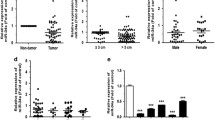Abstract
Objective
To investigate the roles of miR-145 in lung adenocarcinoma (LAC) and to clarify the regulation of N-cadherin by miR-145.
Results
In 57 paired clinical LAC tissues, diminished miR-145 was significantly correlated with the lymph node metastasis and was negatively correlated with N-cadherin mRNA level expression. Wound healing and transwell assays revealed a reduced capability of tumor metastasis induced by miR-145 in LAC. miR-145 negatively regulated the invasion of cell lines through targeting N-cadherin by directly binding to its 3′-untranslated region. Silencing of N-cadherin inhibited invasion and migration of LAC cell lines similar to miR-145 overexpression.
Conclusions
MiR-145 could inhibit invasion and migration of lung adenocarcinoma cell lines by directly targeting N-cadherin.





Similar content being viewed by others
References
Ashaie MA, Chowdhury EH (2016) Cadherins: the superfamily critically involved in breast cancer. Curr Pharm Des 22:616–638
Bartel DP (2004) MicroRNAs: genomics, biogenesis, mechanism, and function. Cell 116:281–297
Calin GA, Croce CM (2006) MicroRNA signatures in human cancers. Nat Rev Cancer 6:857–866
Chen CZ (2005) MicroRNAs as oncogenes and tumor suppressors. N Engl J Med 353:1768–1771
Gao P et al (2013) The molecular mechanism of microRNA-145 to suppress invasion-metastasis cascade in gastric cancer. Oncogene 32:491–501
Hazan RB, Qiao R, Keren R, Badano I, Suyama K (2004) Cadherin switch in tumor progression. Ann NY Acad Sci 1014:155–163
Hulit J et al (2007) N-Cadherin signaling potentiates mammary tumor metastasis via enhanced extracellular signal-regulated kinase activation. Cancer Res 67:3106–3116
Jemal A, Siegel R, Xu J, Ward E (2010) Cancer statistics, 2010. CA: Cancer J. Clinic 60:277–300
Lee JM, Dedhar S, Kalluri R, Thompson EW (2006) The epithelial-mesenchymal transition: new insights in signaling, development, and disease. J Cell Biol 172:973–981
Liu X et al (2009) Uncovering growth-suppressive MicroRNAs in lung cancer. Clin Canc Res 15:1177–1183
Qin X, Yan L, Zhao X, Li C, Fu Y (2012) microRNA-21 overexpression contributes to cell proliferation by targeting PTEN in endometrioid endometrial cancer. Oncol Lett 4:1290–1296
Takai Y, Ikeda W, Ogita H, Rikitake Y (2008) The immunoglobulin-like cell adhesion molecule nectin and its associated protein afadin. Annu Rev Cell Develop Biol 24:309–342
Tanaka H et al (2010) Monoclonal antibody targeting of N-cadherin inhibits prostate cancer growth, metastasis and castration resistance. Nat Med 16:1414–1420
Vora N, Reckamp KL (2008) Non-small cell lung cancer in the elderly: defining treatment options. Semin Oncol 35:590–596
Yin R et al (2011) microRNA-145 suppresses lung adenocarcinoma-initiating cell proliferation by targeting OCT4. Oncol Rep 25:1747–1754
Zhang J et al (2013a) MiR-124 suppresses growth of human colorectal cancer by inhibiting STAT3. PLoS ONE 8:e70300
Zhang X et al (2013b) N-Cadherin expression is associated with acquisition of EMT phenotype and with enhanced invasion in erlotinib-resistant lung cancer cell lines. PLoS ONE 8:e57692
Zheng M, Wu Z, Wu A, Huang Z, He N, Xie X (2016) MiR-145 promotes TNF-alpha-induced apoptosis by facilitating the formation of RIP1-FADDcaspase-8 complex in triple-negative breast cancer. Tumour 37:8599–8607
Acknowledgements
This study was supported by Key Laboratory for Laboratory Medicine of Jiangsu Province of China (No. XK201114) and Project Funded by the Priority Academic Program Development of Jiangsu Higher Education Institutions. We are grateful to the technical support from National Key Clinical Department of Laboratory Medicine of Jiangsu Province Hospital.
Supporting information
Supplementary Table 1—Target sites and sequences of shRNA plasmids.
Author information
Authors and Affiliations
Corresponding author
Ethics declarations
Conflict of interest
The authors declare no conflicts of interest.
Ethical approval
All procedures performed in studies involving human participants were in accordance with ethical standards of the institutional and/or national research committee and with the 1964 Helsinki Declaration and its later amendments or comparable ethical standards.
Additional information
Dongping Mo and Daheng Yang contributed equally to this work.
Electronic supplementary material
Below is the link to the electronic supplementary material.
Rights and permissions
About this article
Cite this article
Mo, D., Yang, D., Xiao, X. et al. MiRNA-145 suppresses lung adenocarcinoma cell invasion and migration by targeting N-cadherin. Biotechnol Lett 39, 701–710 (2017). https://doi.org/10.1007/s10529-017-2290-9
Received:
Accepted:
Published:
Issue Date:
DOI: https://doi.org/10.1007/s10529-017-2290-9




